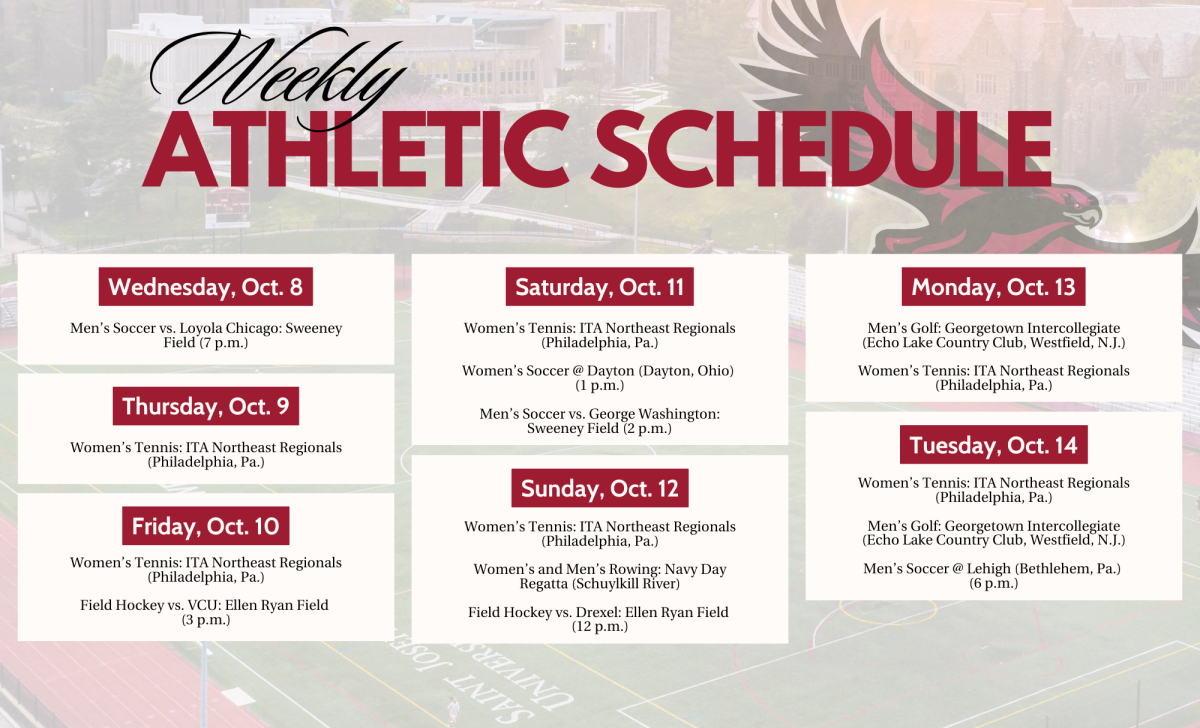Since The Hawk is unable to bring our readers typical sports coverage due to the coronavirus pandemic, we want to reflect on sports highlights from years past. This week’s edition highlights important moments regarding St. Joe’s football team.
Having a football team at St. Joe’s is the punchline of many jokes and nothing more than a pipe dream for St. Joe’s students. However, not many current students know the story of our football team and the historic connection our school has with the sport.
The inaugural season for St. Joe’s football was 1922. At that time, the university was known as St. Joseph’s College. Early on, the team struggled to find a place to practice and play their games. Due to the small size of the school, roster size was also an issue during the early days of the team.
However, that changed in 1929, when the team played their first home game on the brand new Finnessey Field, now Sweeney Field, where the Hawks fought to a tough 7-6 loss to the Pennsylvania Military Academy.
Here are some of the highlights of the St. Joe’s football team:
The Hawk, “Sports-Light,” 1930:
“On the Ides of October, 1929 the Cadets from P.M.C…came marching onto the, as yet unhallowed, turf of Finnessey Field…It was a dusky, fleet-footed sprinter from Ohio [Ken Smith] who saved the Crimson from a total white-wash and sent the Crimson banner to the masthead with the first St. Joe touchdown in the new Stadium… Ken Smith, Hawk quarterback and track star, gathered in the ball near his own goal and leaped ahead. Ken [Smith] galloped through the funnel shaped lane of interference that formed rapidly and was halfway up the field before a hand touched him. After throwing off two desperate tacklers he out-raced the Cadet safety and cavorted gayly over the goal line to a chorus of frenzied cheering from the stands.”
In 1929, St. Joe’s athletic teams officially donned the nickname “Hawks”, which was picked by the student body. According to the student annual, this nickname was a great fit because it was “suggestive of the aerial attack which has made our football team so famous.”
The Hawk, “Hawk Team set for F&M. Opener,” 1931:
“Coach Emid Thomas, head mentor of the Varsity team, has formulated a new system of attack which will encounter its first real test tomorrow. According to form displayed in practice sessions, an aerial game will form the major portion of the Crimson offensive.”
While today you’ll find St. Joe’s and Drexel University duking it out on the basketball court in City 6 matchups, the two schools posed a heated rivalry on the football field. In the all-time series, St. Joe’s held a lead over their rivals winning seven out of eight of the annual contests from 1923.
The 1933 season was thought to be a turning point for the St. Joe’s football program as a whole. After a total of eight games, the Hawks walked away with a mere two wins and one tie. However, their record does not accurately depict the strength and grit of the squad.
Wins over West Chester University and Washington College were backed by a draw with the University of Delaware and hard fought close games against both Muhlenberg College and Susquehanna University.
The Hawk, “McCusker Leads Hawk Scorers; Blue Hen Deadlock Closes Year,” 1933:
“The scoreless deadlock with Delaware ended what St. Joseph’s students are calling the most successful football season in the last four years…A total of 26 points was amassed by the Hawks. Frank McCusker, star end, led the scorers with 13. John Kane with 7 and Jim McGonegal with 6, followed him.”
From there the Hawks only continued to get better, and in 1936 they set a record scoring 59 points over Brooklyn College. That same season, wins over the University of Delaware and LaSalle University guided the team to their best season record since the induction of Finnesey Field, fighting for six wins over the course of nine games.
The Hawk, Joe Duval ’37:
“On the whole, I think the past season shows a definite trend toward better football teams at St. Joseph’s. Coach Heinie Miller is developing a great bunch of young players who, in a few years, will be the best in the circuit.”
However, after a few more successful seasons from 1937-39, Miller announced at the completion of the 1939 season that he was leaving to join the Philadelphia Eagles in a new coaching role. With Miller’s departure, University President Rev. Thomas J. Love announced that the athletics department would be disbanding the football program for the foreseeable future.
The decision was a tough one for the athletics department and in an open letter to students in The Hawk, Director of Athletics Father Aloysius S. Travers, S.J. wrote:
“On reviewing the facts and figures of the last six years we had to accept the hard conclusion that football at St. Joseph’s had never measured up to the expectations that brought it to life. The conviction was inescapable that to continue football would be unjust to every athletic department and unfair to the great majority of students.”
While the story of a football program on Hawk Hill is a rather brief one, there is no doubt it brought joy to former students in a time of transition and growth for St. Joe’s.
The Hawk, “Football at St. Joseph’s College,” 1931:
“The history of St. Joseph’s in the football world is not one to make fans stay up at nights, nor send them home talking to themselves, but it is one that represents the joys and sorrows of students dating from the new era, 1919, when the college separated from the high school and began intercollegiate competition.”














































